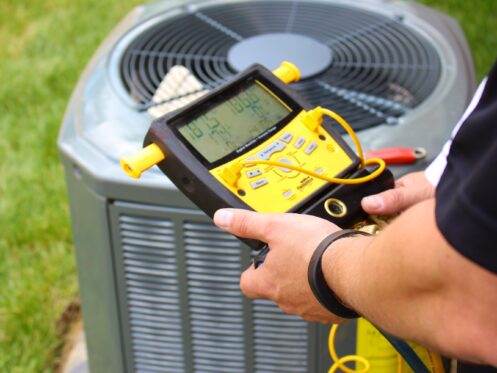If your HVAC system isn’t cooling your home as it should, it can make indoor conditions uncomfortable and frustrating. There are several possible reasons why your HVAC system might not be producing cold air, and understanding these causes can help you take the right steps to address the problem.
Check Your Thermostat
If your HVAC system isn’t cooling your home, your thermostat could be part of the problem. First, ensure that your unit is set to cooling mode and that the temperature setting is lower than the current temperature inside your home. If the setting is too high, your AC will not kick on.
You should also check your thermostat’s batteries. Dead or weak batteries can cause it to malfunction or lose the settings you programmed in. It’s recommended to change the batteries in your thermostat at least once a year to prevent issues.
In addition to batteries, other factors could be at play. Over time, the sensors and wiring inside your thermostat can degrade, affecting the accuracy of its temperature readings. A professional technician can inspect your thermostat for faulty components and recommend a solution.
Finally, if your thermostat is nearing the 10-year mark, it may be time to consider a replacement. As thermostats age, their performance can decline, leading to inaccurate readings.
Replacing your thermostat with an updated model offers several benefits, including improved energy efficiency, better temperature control, and enhanced features like smart connectivity. Modern thermostats can be programmed to adjust temperatures based on your schedule, helping to reduce energy consumption and lower utility bills. Some models even allow remote control via smartphone apps, providing greater convenience and control over your home’s climate.
Upgrading your thermostat can be a simple yet effective way to solve the problem and may boost your HVAC system’s performance and your overall comfort.
Inspect Your Air Filter
An air filter prevents dust and debris from entering your cooling system and damaging its internal components. It also plays an important role in maintaining indoor air quality by capturing airborne pollutants that would otherwise recirculate through your living spaces. However, if yours has become clogged, it can lead to a host of issues, including preventing your system from cooling your home.
Experts recommend changing air filters at least every three months. Depending on factors such as the number of people in your home and whether you have pets, you may need to change yours more often. Many homeowners check their filters once a month to know when it’s time for a fresh one.
Inspect your filter for any signs of debris buildup or damage. A dirty filter typically appears gray and may have visible clumps of dust. If you hold a dirty filter up to a light, you’ll notice little to no light passing through it.
When replacing your filter, make sure to select the correct size for your HVAC system. Choosing one that’s too small or too large can affect airflow and lead to problems. Additionally, pay attention to the MERV rating, which indicates the filter’s efficiency. While a high MERV rating can improve indoor air quality, it may also be too restrictive for your system, potentially leading to strain and a lack of cold air from your vents.
Blocked or Closed Vents
In addition to clogged filters, airflow issues can be caused by blocked supply or return vents. This creates uneven air pressure within your ductwork, causing your system to work harder than necessary to maintain the desired temperature. Added strain can lead to insufficient cooling in certain areas of your home, leaving some rooms unbearably hot while others remain comfortable. In addition to ensuring that household items such as area rugs, furniture, and curtains are not blocking vents, make sure they are all in the open position for proper airflow.
Addressing Condenser Problems
Your outdoor condenser unit is a vital component of your air conditioning system, and several issues can affect cooling efficiency. One common problem is when its internal components become blocked by leaves, dirt, or other debris. These obstructions can restrict airflow and even cause the fan blades to struggle or even stop spinning entirely. If the fan blades are not spinning, it’s a good idea to contact a professional AC repair team to clear the blockage. They can also assess if the strain has damaged the fan motor or other parts and perform any necessary repairs.
To prevent condenser issues in the future, keep the area around the unit clear. It should have at least 2 feet of clearance on all sides. This prevents airflow issues that can prevent your system from keeping your home as cool as you would like.
Refrigerant Issues
Another common issue that can prevent your HVAC system from blowing cold air is a refrigerant problem. As your AC system ages, it’s more prone to refrigerant leaks. A professional technician can check your system for low refrigerant levels and seal any leaks. Once they are addressed, the system will need to be recharged with refrigerant to restore its cooling efficiency.
Frozen Evaporator Coils
Frozen evaporator coils will also prevent your HVAC system from cooling your home. This problem is usually caused by restricted airflow, which prevents the coils from absorbing heat properly. When airflow is insufficient, the coils get too cold and can freeze over.
If you notice frozen coils, the first step is to turn off your HVAC system and let the coils thaw. This may take several hours, so be patient. Also, consider putting some towels under the air handler to absorb water as the coils thaw.
While the system is off, check for anything causing airflow restrictions, such as a dirty air filter or closed vents. Once the coils have thawed, ensure there are no blockages before turning the system back on.
If frozen coils continue to be a problem, it’s a good idea to call a professional to inspect your system. Persistent freezing could indicate deeper issues, such as low refrigerant or a problem with the blower, that need to be addressed by a professional.
Preventing AC Problems
Routine maintenance is the best way to prevent cooling system issues. During an annual tune-up, a technician will inspect and clean key components, ensuring your system operates efficiently and reliably. They will also inspect the blower motor, fan, and electrical components for wear and tear. Loose connections, failing capacitors, or malfunctioning relays can all impact your system’s ability to cool effectively. They will also lubricate all moving parts to reduce friction. Finally, the technician will tune up and recalibrate your air conditioner to ensure it’s running at peak efficiency.
Contact Your Local Professionals
At Kalins Indoor Comfort, we have been serving the residents of Sioux City, IA and the surrounding areas for over 100 years. We install, maintain, and repair cooling systems. Additionally, we can help with all your other HVAC needs, including replacing your older thermostat with a smart model. Contact us today to schedule an appointment with one of our experienced technicians.











